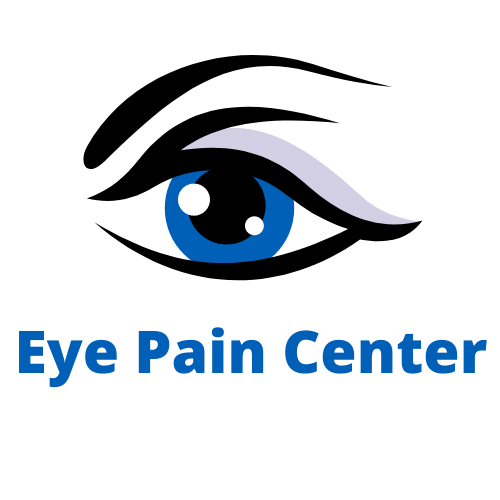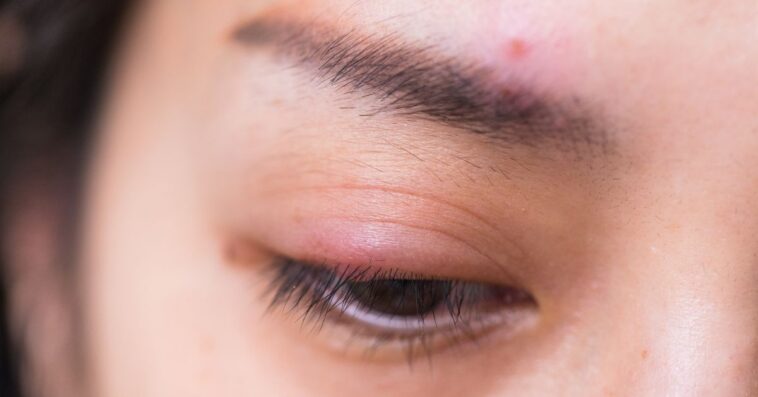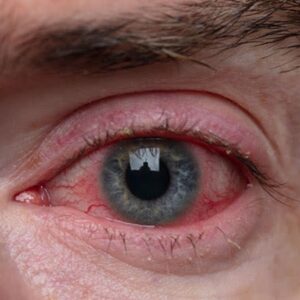Eye pain may occur in several different forms. It can feel sharp, dull, throbbing, burning, or like a deep ache behind the eye. Sometimes, pain is only noticeable when blinking. In other cases, it may spread to the temples or cause a headache behind the eyes. In certain situations, eye pain can signal a more serious underlying condition that needs prompt medical attention.
The eyes contain many nerves, so even minor issues can cause significant discomfort. However, it is important to understand that severe eye pain does not always indicate a serious problem. Learning about the type of eye pain you are experiencing and what it may mean is an important step in deciding how to care for your eyes.
Eye Pain Symptoms
Sharp pain in the eye
- Corneal abrasion
- Dry eye flare
- Foreign body
- Early infection
Burning eye pain
- Dry eyes
- Blepharitis
- Allergies
- Digital eye strain
Pain behind the eye
- Sinus infections
- Migraines
- Optic nerve inflammation (optic neuritis)
- Tension headaches
Eye pain and headache together
- Migraines
- Cluster headaches
- Eye strain
- Glaucoma (more serious)
Eye pain when blinking
- Corneal scratch
- Stye
- Conjunctivitis
- Dry eye
- Eyelid inflammation
Eye socket pain
- Sinus issues
- Orbital inflammation
- Nerve pain
- Traumatic injury
Common Causes of Eye Pain
1. Dry Eye Syndrome
Symptoms of dry eye may become worse in the following situations:
- After screen time
- In air-conditioned spaces
- During windy weather
2. Eye Strain (Digital Eye Strain)
Common symptoms of eye strain may include the following:
- Dull ache
- Eye pressure pain
- Headache behind the eyes
3. Conjunctivitis (Pink Eye)
Pain from conjunctivitis may feel like one of the following:
- Burning
- Rawness
- Mild stinging
4. Corneal Abrasion
- Sharp pain in the eye
- Eye pain when blinking
- Tearing
- Light sensitivity
5. Stye or Chalazion
Pain from a stye or chalazion often becomes worse when you blink or touch the affected eyelid.
6. Sinus Infection
- Pain behind the eye
- Eye socket pain
- Headaches
- Facial pressure
7. Migraine or Cluster Headache
Cluster headaches, in particular, may cause severe, stabbing pain around one eye.
8. Uveitis (Inflammation Inside the Eye)
- Deep eye pain
- Redness
- Light sensitivity
- Blurry vision
9. Optic Neuritis
Typical symptoms of optic neuritis include the following:
- Pain behind the eye
- Pain when moving the eye
- Vision dimming
- Color changes
10. Acute Angle-Closure Glaucoma (Emergency)
This is a medical emergency and requires immediate attention.
- Severe eye pain
- Headache
- Nausea
- Halos around lights
- Sudden blurry vision
Where Eye Pain Happens in the Eye?
Surface of the eye (cornea, conjunctiva)
Inside the eye (uvea, lens, optic nerve)
Eye socket and surrounding tissues
Eyelids
Emergency Signs of Eye Pain You Should Never Ignore
✔ Eye pain with vision loss
✔ Haloes around lights
✔ Eye pain with nausea or vomiting
✔ Pain after trauma or chemical exposure
✔ A feeling that something is stuck in the eye and won’t go away
✔ Bulging of the eye
✔ Eye pain with fever or swelling
- Acute glaucoma
- Orbital cellulitis (dangerous infection)
- Corneal ulcer
- Retinal detachment
- Chemical burn
- Traumatic injury
How Eye Doctors Diagnose Eye Pain?
When you visit your eye doctor with eye pain, your doctor does not rely on a single test. Each part of the examination provides a different clue about what is causing the discomfort, and together they help build a clear picture of the problem.
The goal is not only to confirm the issue, but also to ensure you receive the right treatment from the beginning.
Visual acuity test
This is the familiar eye chart. It helps your eye doctor determine how well you can read letters up close and at a distance, and whether pain is affecting your vision.
Slit-lamp examination
Using a special microscope, your doctor looks closely at the front of the eye, your cornea, eyelids, and the thin tissue covering the eye’s surface. This is often where early signs of irritation or infection show up.
Fluorescein staining
A gentle dye is placed on the eye to highlight scratches, small injuries, or ulcers on the cornea. Even problems you cannot see in the mirror become visible under a blue light.
Tonometry
This quick pressure check helps rule out glaucoma or dangerous increases in eye pressure that can cause severe pain.
Pupil evaluation
Your eye doctor shines a light to observe how your pupils react. The response indicates how well the optic nerve is functioning.
Retinal examination
By examining the back of the eye, the doctor checks for swelling, bleeding, or inflammation. These issues can cause pain behind the eye or changes in vision.
These tests are not routine. They are ordered only when a deeper problem is suspected, such as sinus disease, orbital infection, or an optic nerve issue.
Treatment Options For Eye Pain
Dry Eyes
- Artificial tears
- Warm compresses
- Omega-3 supplements
- Increasing blink rate during screen use
Eye Strain
- 20-20-20 rule
- Better lighting
- Limiting screen time
Conjunctivitis
- Antibiotics (bacterial)
- Antihistamines (allergic)
- Cool compresses
Corneal Abrasion
- Lubricating drops
- Antibiotic drops
- Avoid contact lenses
Stye
- Warm compresses
- Eyelid cleaning
Sinus-Related Eye Pain
- Decongestants
- Nasal sprays
- Hydration
Uveitis
- Prescription anti-inflammatory eye drops.
- Oral medication in some cases
Acute Glaucoma
This treatment is not optional, as acute glaucoma can cause permanent vision loss.
Home Remedies That Actually Help Eye Pain
✔ Artificial tears (preservative-free)
✔ Humidifier
✔ Frequent blinking
✔ Cold compress for allergies
✔ Proper hydration
✔ Breaks from screens
✔ Gentle temple massage
✘ Rubbing the eyes
✘ Using old contact lenses
✘ Using eye drops that are not prescribed
When to See an Ophthalmologist Immediately
- Sharp eye pain that keeps getting worse
- Eye pain with blurry or double vision
- Eye pain after trauma
- Pain when moving the eye
- New floaters or flashes of light
- Eye pain with severe headache
- Pain behind one eye with nausea
Conclusion
Eye pain is common, but you should never ignore it, especially if you notice vision changes, headaches, pressure, or worsening symptoms.
Knowing what kind of pain you have can help find the cause. Because eyes are delicate, it’s always safest to have ongoing or severe pain checked by an eye doctor.






